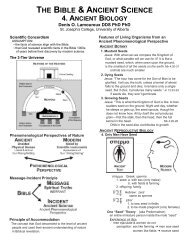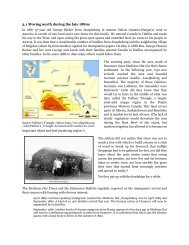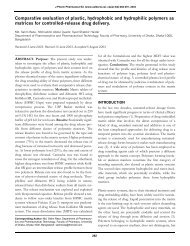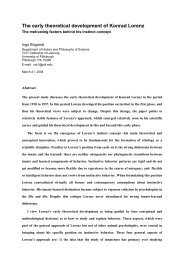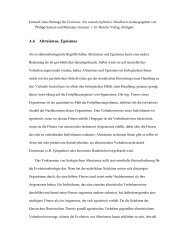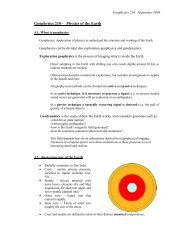Processing of Primary Fischer-Tropsch Products - University of Alberta
Processing of Primary Fischer-Tropsch Products - University of Alberta
Processing of Primary Fischer-Tropsch Products - University of Alberta
You also want an ePaper? Increase the reach of your titles
YUMPU automatically turns print PDFs into web optimized ePapers that Google loves.
oligomerisation due to the low olefin content <strong>of</strong> the primary product. If the<br />
olefins lighter than diesel are converted to the diesel boiling range then the<br />
remaining naphtha may not require hydrogenation to improve the storage<br />
stability. Oligomerisation has already been discussed in relation to the refining <strong>of</strong><br />
HTFT products so the remainder <strong>of</strong> the discussion on the processing <strong>of</strong> LTFT<br />
products will focus on the hydroprocessing operations.<br />
The hydrocracking <strong>of</strong> the heavy paraffins serves two purposes, to reduce<br />
the boiling range to middle distillates and to improve the cold properties as the<br />
hydrocracked products are mostly branched.<br />
Currently the production <strong>of</strong> a high quality diesel fuel is a preferred option<br />
to the production <strong>of</strong> gasoline. This is because the very factors which count<br />
against FT gasoline, viz. product linearity and low aromatic content, are very<br />
positive factors in favour <strong>of</strong> high quality, i.e. high cetane number, diesel fuel.<br />
For maximum production <strong>of</strong> high quality diesel fuel the slurry bed reactor<br />
operating in the high wax selectivity mode with either iron or cobalt based<br />
catalysts, between 210 and 260 ~ and about 3Mpa, is the recommended route.<br />
The straight run FT diesel makes up about 20% <strong>of</strong> the total FT product and<br />
because it is predominantly linear it has a cetane number <strong>of</strong> about 75. Note that<br />
at present the specified cetane number <strong>of</strong> diesel fuels varies from about 40 to 50,<br />
depending on the location. The FT slurry reactors are operated for maximum<br />
wax production because subsequent down stream hydrocracking <strong>of</strong> the wax<br />
under relatively mild conditions makes the largest contribution to the final diesel<br />
fuel pool. In the case <strong>of</strong> cobalt catalysts there are two reasons for operating the<br />
FT process at high pressures, the wax selectivity increases with pressure (see<br />
Chapter 3, Section 9.3.2) and the degree <strong>of</strong> branching decreases [64]. The<br />
hydrocracking <strong>of</strong> wax with standard bi-functional catalysts was investigated at<br />
Sasol during the 1970's [65, 66]. Mild catalytic hydrocracking <strong>of</strong> the wax yielded<br />
about 80% diesel, 15% naphtha and 5% C1 to C4 gases. The product cut heavier<br />
than diesel was recycled to extinction. Simple calculation shows that the above<br />
product yields are the result <strong>of</strong> random beta scission along the linear wax chains.<br />
There is therefore a big incentive to improve the selectivity <strong>of</strong> the wax<br />
hydrocracking operation in order to increase the diesel cut yield. Some chain<br />
branching does occur during the wax hydrocracking operation and so the cetane<br />
number <strong>of</strong> the diesel fuel produced is somewhat lower than that <strong>of</strong> the straight-<br />
run FT diesel. The final diesel pool nevertheless has a cetane number <strong>of</strong> above<br />
70. The naphtha produced in the wax hydrocracking process consists only <strong>of</strong><br />
alkanes. The naphtha produced in the FT process also consists predominantly <strong>of</strong><br />
linear alkanes. To convert these two naphtha cuts to in- specification gasoline<br />
would require a considerable amount <strong>of</strong> further octane number upgrading.<br />
However, since these naphthas consist essentially <strong>of</strong> linear alkanes they would<br />
be an excellent feedstock for the production <strong>of</strong> ethylene by steam cracking,<br />
505



